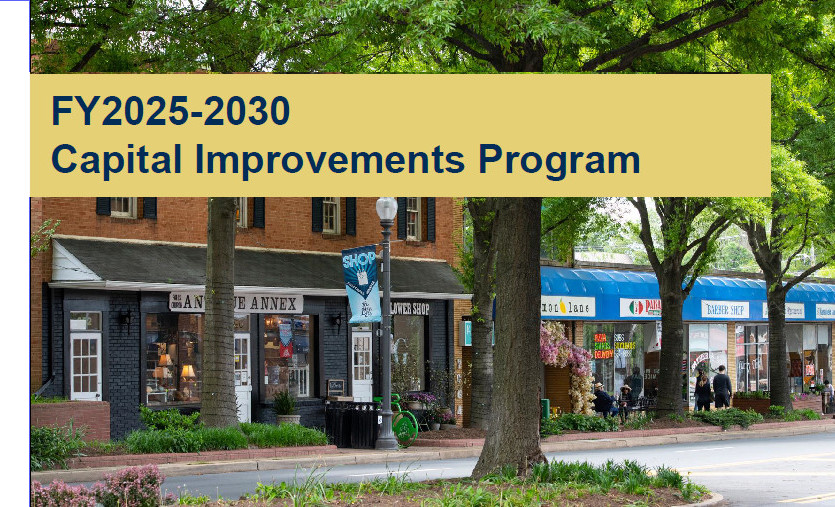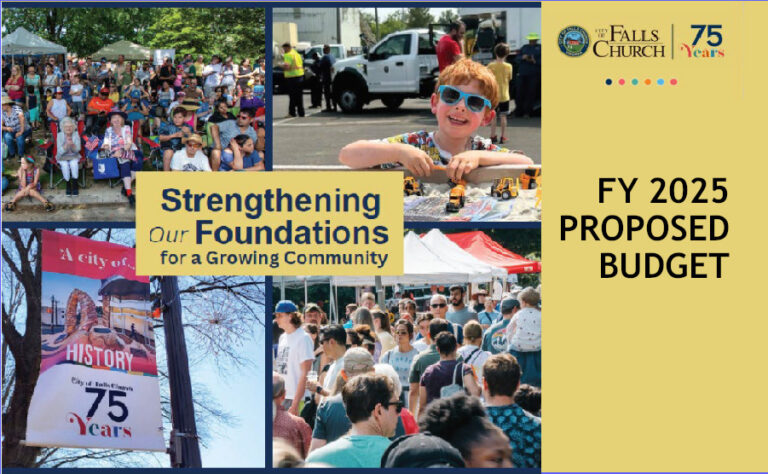The Capital Improvement Program (CIP) 2025 and Beyond
Summary
- The six-year CIP for 2025 – 2030 is $191 million, a third of that coming from grants.
- Debt of $60 million is expected to be issued in that period – $28 million for the Sewer utility, $30 million for the Property Yard and $2 million for the Stormwater utility.
- For FY 2025, projects to be funded include new radios for the Police, new heating and air conditioning (HVAC) for the Community Center, $1.45 million for the Meridian High School Stadium and turf, a new pedestrian bridge for Sherrow Avenue, upgrades to traffic signals and Lincoln Avenue repaving.
- City Hall has already run out of space for staff and is looking to lease an additional 5,000 sf of office space.
- The City needs to study the adequacy of current arrangements with Fairfax and Arlington for fire and emergency medical services, given the rapid growth of Falls Church. Inadequacies may require capital funds to resolve.
Background
The City’s capital plan, known as the Capital Improvement Program (CIP), for 2025-2030 was discussed at the City Council meeting on April 8, 2024. Capital planning is a component of the City proposed budget and represents the City’s long-term plan to achieve its strategic goals. This post explains the capital plan, summarizes the major projects for 2025, and the City Council discussion.
The six-year plan amounts to $191 million and is to be financed by City revenues, federal and state grants, and debt. The CIP includes $51 million of capital expenses for the sewer and stormwater utility. Discussion of the sewer utility’s finances and capital expenditures will be discussed in a later post. This post is concerned with the remaining $140 million of the capital plan.
Planning for capital expenses
Capital expenditures are funds used to acquire, upgrade and maintain physical assets such as property, infrastructure (e.g., roads, pipes, bridges), technology, and equipment. These assets all have a life of more than a year. The expenses involved are recorded in the City’s financial accounts as assets to be written off as depreciation over many years.
These projects cost more than $150,000 and often require multi-year planning and construction. Because of this, and the longer life of these assets, plans for capital expenditure cover multiple years. The City’s capital plan looks out six years in detail and 10 years in aggregate. This year’s plan will cover 2025 to 2030.
Funding source
Projects are paid for with City funds and outside grants. The City has a total of $191 million in projects for 2025-2030, an increase of $38 million from last year’s CIP. The table below gives an overview of the projects and expected funding sources.
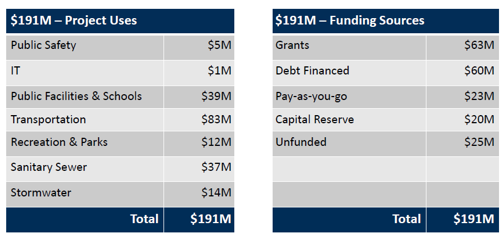
Pay-as-you-go are funds directly from the City revenue into CIP each year. Capital Reserve is from the general fund, that is, the City’s “savings accounts.” Both are allocated to the CIP funds through the yearly City budget, read A Review of the Proposed FY 2025 Budget. Project managers spend much effort in procuring grants that make up a third of the cost of the projects. The remaining shortfall is financed by issuing bonds, i.e., debt.
The CIP 2025-2030 funding plan by year
The table below shows the funding plan for the CIP from 2025 to 2034 (10 years) with yearly summaries for the first six years (2025 to 2030). “General/School Fund” refers to the CIP fund in the City budget, and “Transportation” refers to the Special Transportation Fund. It shows the expected funding allocation from the City’s budget each year.
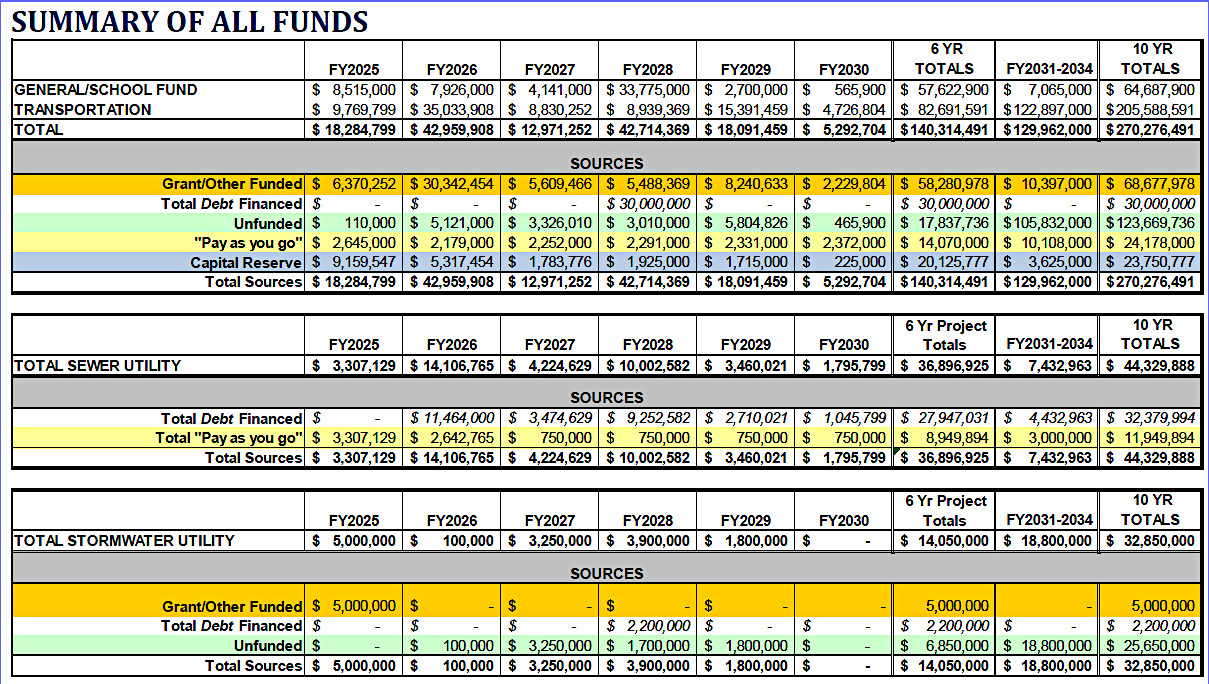
For 2025, the capital plan requires a total of $18.3 million, divided between transportation ($9.8m) and all other CIP projects ($8.5m). $11.8 million (Pay-as-you-go + Capital Reserve) will be transferred into these funds according to the proposed budget. $6.4 million in grants are expected, leaving a shortfall of $110,000. No debt will be issued.
The table also shows the expected allocation from future years’ budgets and grants. A total of $20 million will be drawn from the Capital Reserve over the next six years. This reserve represents accumulations of past years to pay for capital projects. The City had a fund balance of about $50 million at the start of 2024, with about half designated as Capital Reserve.
The CIP plan shows a debt issue of $30 million in 2028. This is to pay for a redo of the City’s Property Yard area around Gordon Road.
(Not all items listed in the CIP are capital expenses. Some, such as the Washington Metropolitan Area Transit Authority (WMATA) annual cost, are included because they draw funds from the Special Transportation Fund for regulatory reasons.)
A note on the utility capital plans
Notice that this table includes separate capital plans for the Sewer utility and Stormwater utility. The utilities are set up financially as stand-alone enterprises. The Sewer capital plan shows $28 million in debt to be issued from 2026 to 2030. This is for the increased capacity needed and the new flow equalization tank, read The Little City’s Big Sewage Challenge – Part 2: Has Growth Paid For Growth? This will be discussed separately in a later post.
Council discussion
(To follow the discussion, it may be useful to refer to the next section that lists the projects in the CIP for FY 2025.)
Councilmember Caroline Lian was concerned that the City was not leveraging the capital funds to fund the headcount needed to manage the CIP projects, thus capitalizing the expense instead of charging the headcount to the operating budget. Staff responded that it would make sense to do that for projects that receive grant funding, otherwise it made no difference to the City cash flow.
Councilmember Marybeth Connelly asked about the City Hall Annex in the CIP. Deputy City Manager Andy Young explained that the City would need to lease additional office space for 25 employees because of the growth in the number of employees. The lease is estimated to cost $175,000 a year (a City budget expense, not CIP). Councilmember Debora Schantz-Hiscott suggested that staff look at using the top floors of Meridian High School that are currently unused. The newly renovated City Hall was opened in 2020, and Mr. Young said they are already short of space.
Mayor Letty Hardi wanted to reassure the public that the City has the funds to cover the $20 million capital reserves withdrawal over the next six years and still has enough funds leftover.
Ms. Hardi also asked why the Noland Street sidewalks project was not going to be addressed until 2030. Grant Manager Caitlin Sobsey said that the Noland Street sidewalk work is relatively expensive at about $530,000 because sections of the sidewalk will have to be moved. Ms. Hardi requested a comprehensive list of sidewalks that need to be addressed so that they can be prioritized against other CIP items, e.g., the Meridian High School concession stand.
Ms. Connelly expressed concern that the City may be doing too much. Mr. Young explained that the CIP for 2025 is $20 million less than for 2024, and the extra staffing request is aimed at “unclogging” the CIP. Ms. Sobsey clarified that the grant funding (mostly in transportation) typically has a 2-year cycle, and staff need to respond to that cycle. This year is an off year for grants, allowing staff to work on other projects.
Councilmember David Snyder said that he was concerned that the City was not addressing Fire and Emergency Medical Services, given that we are adding more senior residential units in the Quinn Homestretch project and in the West Falls development. Furthermore, he noted, these are 10-story and 18-story buildings. He asked if the City should review its agreement with Arlington and study the adequacy of the current arrangements.
Mr. Snyder said, “We’re relying on Mutual Aid agreements with Fairfax, which is very nice of them. We appreciate it, but they may decide at some point they don’t want to do that.” He asked, “Are we studying to make sure that that element of basic core services is adequately provided for in the near and long term?” As an example, he suggested the possibility that a new fire station may be needed.
City Manager Wyatt Shields said that Arlington is currently reviewing their comprehensive plan for Fire and Life Safety services and the City is “plugged into that effort.” He agreed to follow up with Arlington on this issue.
CIP projects receiving FY 2025 funds
The City currently has 53 open projects, including eight projects that were added this year. Not all projects are active and require funds in 2025. Projects with expenses in fiscal year (FY) 2025 are listed below. All projects are to receive money from the CIP fund except the transportation projects. Funding for transportation projects will come from the Special Transportation Fund that was set up to properly account for state and federal dollars received, such as from the Northern Virginia Transportation Authority.
Public Safety
- Public Facility Security ($500K, $900K over two years)
Create one centric system (card access, alarms, and cameras) that can be monitored in the Public Safety Dispatch Center. City buildings included in the overall system are the Property Yard, the Community Center, Aurora House, Cherry Hill Farm House, Cherry Hill Barn, Gage House, the Library, City Hall, and Fire Station 6. - Fire Hydrants ($375K, $1.9m over four years)
Install 60 fire hydrants, both new and replacements. Fifteen hydrants will be installed for $375K each year. - Public Safety Radios ($1.5m)
Update the Police and Sheriff department’s radio system with a new Motorola radio system that would include approximately 100 APX 8000 portable models, 52 APX 8500 mobile units, and two APX 7500 Multiband Consolettes.
Information Technology
- Core infrastructure reinvestment ($250K)
Replace core network infrastructure and edge devices to modernize network backbone and enhance security perimeter.
Public Facilities
- Cherry Hill Farm House structural repairs ($250K)
- Set up a Police Substation of 500 sf at West Falls ($125K)
- City Halls Annex ($375K) – Fit out 5,000 sf of office space
- Community Center HVAC ($2.9m)
The current system has major parts that are between 15 and 35 years old and some no longer operational. The new system will be based on heat pumps and geothermal energy. - Vehicle replacement and chargers ($360K)
Replacement of police and other vehicles with EV/Hybrid ones. Also installation of EV chargers. A set number is planned for each year.
Recreation and Parks/Fields
- Berman Park playground equipment ($495K – 46% developer funded)
Falls Church City Schools
- Meridian High School Stadium Complex ($600K)
Upgrade the concession stand, restrooms and press box - Meridian High School synthetic turf replacement ($850K)
Synthetic turf has a life of nine to 10 years.
Transportation
- Sherrow Avenue Bridge replacement ($1.2m) – 100% grants
- Lincoln Avenue Repaving ($1.35m) – 50% state funds
This will be coordinated with the Greening of Lincoln stormwater project. - Traffic signals and a roundabout ($2.7m) – 50% state funds
Partial funding this year for upgrades to traffic signals at Hillwood Avenue and Annandale Road and at W Broad and Spring Streets. Construction will begin on the traffic signals at N Washington and Columbia Streets and a roundabout at S Maple Avenue and Annandale. Funding for these two projects occurred in 2024. - Traffic calming ($200K) – 50% grants
In the Greenway Downs neighborhood - Multimodal Connectivity ($1.4m) – 100% grants
Bikeshare, S Washington Street bus stop, traffic calming improvements.
Below are two tables summarizing all the projects that are currently open in the CIP, excluding the utility projects. The year in which funding is needed roughly corresponds to when they will become active.
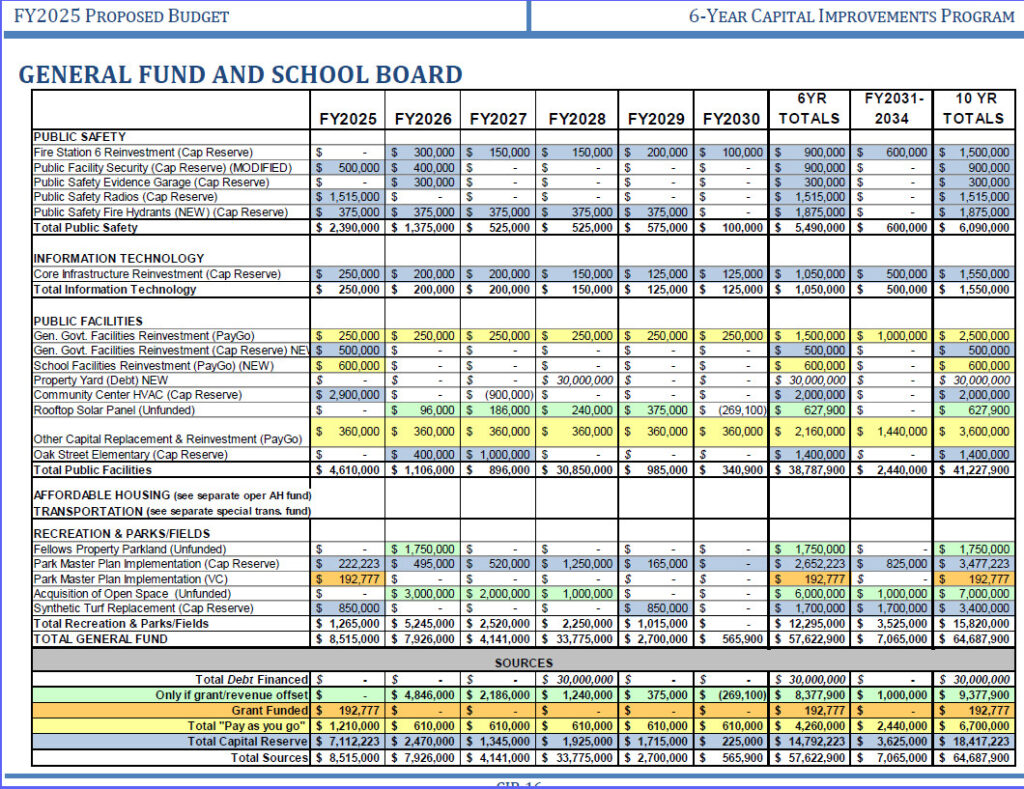
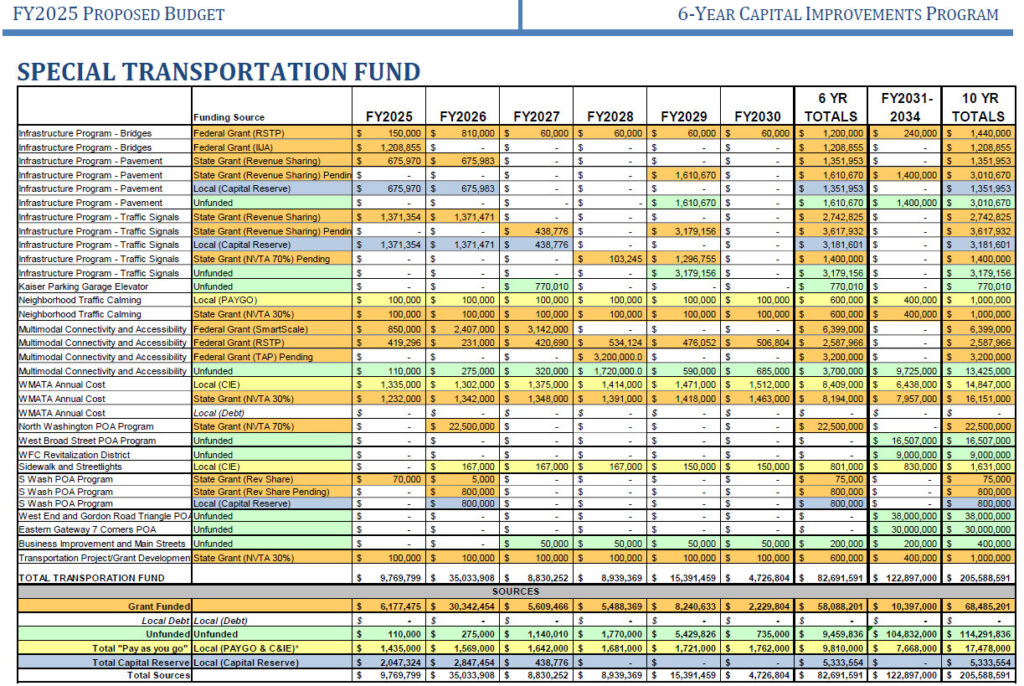
The budget and CIP schedule
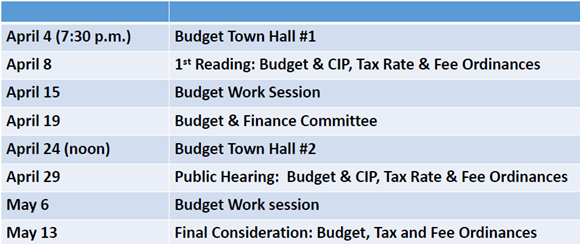
The schedule above shows the meetings that have been scheduled on the budget and CIP. A town hall was held on April 4, and a second one is scheduled for April 24 with a public hearing slated for April 29. The final budget, including the CIP, will be voted on by the City Council on May 13. The budget is scheduled to go into effect on July 1, 2024.
References
- FY2025-2030 Capital Improvements Program – revised 3-20-2024, City of Falls Church Six-year Capital Improvements Program FY 2025-2030. This 178-page document includes information about individual projects in the CIP.
- City Council meeting, April 8, 2024. YouTube video.
- City Council meeting, April 8. 2024. This video will not display properly on a small screen as it includes the agenda document.
- 04-08-24 CIP Work Session Slides. Staff presentation at the City Council work session, April 8,2024.

